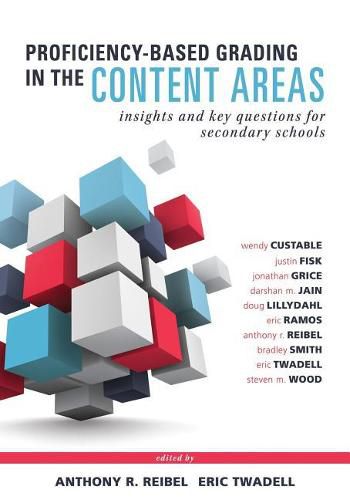Readings Newsletter
Become a Readings Member to make your shopping experience even easier.
Sign in or sign up for free!
You’re not far away from qualifying for FREE standard shipping within Australia
You’ve qualified for FREE standard shipping within Australia
The cart is loading…






No matter the content area, evidence-based grading puts student growth at the heart of the classroom. Designed for teachers and administrators of grades 6-12, Proficiency-Based Grading in the Content Areas details a five-step approach for implementing evidence-based grading and maintaining its effectiveness over time. This book equips any educator – from technical to fine arts – with the tools and support to make the shift to focusing on standards and competency.
Use proficiency-based grading (also known as evidence-based grading) to drive student success:
Become familiar with the basic concepts and essential decisions of evidence-based grading that apply to teaching in all content areas. Learn the five phases of implementing proficiency-based grading – (1) preparation, (2) incubation, (3) insight, (4) evaluation, and (5) elaboration. Explore the steps, paradigm shifts, and pedagogy necessary to implement proficiency-based grading in a particular content area. Study individual-level and institutional-level grading decisions and how they differ from each other. Understand how proficiency-based grading differs from content area to content area and the unique benefits it offers to each.
Contents:
Introduction
Chapter 1: Implementing Proficiency-Based Grading With Core Belief Fidelity
Chapter 2: Implementing Evidence-Based Reporting in Career and Technical Education
Chapter 3: Implementing Evidence-Based Grading in English Language Arts
Chapter 4: Implementing Evidence-Based Grading in Fine Arts
Chapter 5: Implementing Evidence-Based Grading in Mathematics
Chapter 6: Implementing Evidence-Based Grading in Physical Education and Health
Chapter 7: Implementing Evidence-Based Grading in Sciences
Chapter 8: Implementing Evidence-Based Grading in Social Sciences
Chapter 9: Implementing Evidence-Based Grading in World Languages
Epilogue: Creating Self-Reliant Learners
References and Resources
Index
$9.00 standard shipping within Australia
FREE standard shipping within Australia for orders over $100.00
Express & International shipping calculated at checkout
No matter the content area, evidence-based grading puts student growth at the heart of the classroom. Designed for teachers and administrators of grades 6-12, Proficiency-Based Grading in the Content Areas details a five-step approach for implementing evidence-based grading and maintaining its effectiveness over time. This book equips any educator – from technical to fine arts – with the tools and support to make the shift to focusing on standards and competency.
Use proficiency-based grading (also known as evidence-based grading) to drive student success:
Become familiar with the basic concepts and essential decisions of evidence-based grading that apply to teaching in all content areas. Learn the five phases of implementing proficiency-based grading – (1) preparation, (2) incubation, (3) insight, (4) evaluation, and (5) elaboration. Explore the steps, paradigm shifts, and pedagogy necessary to implement proficiency-based grading in a particular content area. Study individual-level and institutional-level grading decisions and how they differ from each other. Understand how proficiency-based grading differs from content area to content area and the unique benefits it offers to each.
Contents:
Introduction
Chapter 1: Implementing Proficiency-Based Grading With Core Belief Fidelity
Chapter 2: Implementing Evidence-Based Reporting in Career and Technical Education
Chapter 3: Implementing Evidence-Based Grading in English Language Arts
Chapter 4: Implementing Evidence-Based Grading in Fine Arts
Chapter 5: Implementing Evidence-Based Grading in Mathematics
Chapter 6: Implementing Evidence-Based Grading in Physical Education and Health
Chapter 7: Implementing Evidence-Based Grading in Sciences
Chapter 8: Implementing Evidence-Based Grading in Social Sciences
Chapter 9: Implementing Evidence-Based Grading in World Languages
Epilogue: Creating Self-Reliant Learners
References and Resources
Index